
By Kari Lydersen, Energy News Network
This story was first published on the Energy News Network and was republished here with permission.
A two-year-old economic development partnership is helping to draw attention — and investment dollars — to sustainability projects in the Great Lakes region.
The Great Lakes Impact Investment Platform was launched by the Conference of Great Lakes and St. Lawrence Governors and Premiers. The alliance of U.S. and Canadian officials from Québec to Minnesota is focused on growing the region’s economy and protecting its fresh water.
The investment platform is helping to do both, promoting investment opportunities that benefit the environment, including renewable energy, clean water, and ecological restoration. The platform features 40 projects representing nearly $4.5 billion in investments, including household energy efficiency retrofits, coal mine reclamation, and utility-scale solar development.
“Global capital markets are hungry” for chances to invest in green projects, said Dave Naftzger, the conference’s executive director. But financial institutions, philanthropic entities and others have long looked to the coasts for such opportunities.
Great Lakes states offer untapped potential that can pay off for investors as well as regular citizens and the environment, Naftzger said. And even with increasing federal action, including incentives and programs under the new U.S. infrastructure law, a swift and equitable clean energy transition will still depend on private investment and public-private collaborations.
“Especially for investors who care about water, they should look to the Great Lakes as a matter of course,” Naftzger said. Meanwhile, clean energy-related investments are also a robust and growing sector, including projects tapping green bonds, property assessed clean energy programs, and other financial tools to leverage public and private funds.
The platform is something of a matchmaking service, publicizing green investment opportunities and projects and helping to connect funders and lenders with these initiatives, while also allowing projects to learn from each other.
Among the energy-related projects showcased by the platform:
- LaCrosse, Wisconsin’s ambitious municipal solar program in partnership with local corporation Johnson Controls
- Detroit utility DTE’s green bond program funding renewable generation
- The Michigan Saves program offering quick and streamlined capital for large and small energy efficiency and renewable projects
- A renewable energy cooperative developing renewables in Ontario
- C-PACE manager CounterpointeSRE development of green roofs, energy efficiency, and other building investments in Minnesota, Detroit and Chicago
- Capital firm Quantified Ventures’ use of carbon credits to reforest former coal mine land
Such green investing helps developers, governments and even individual households access capital that they might not have been able to otherwise. And it allows financial institutions and other funders to meet environmental and sustainability goals and serve clients who want their money to go into green efforts.
“There’s a lot of place-based investors — people who are specifically looking for opportunities here” in the Great Lakes, Naftzger said. “That could include pension funds, high-net-worth individuals, family offices, community foundations, philanthropic organizations. And these deals can provide market returns or better. … We’re helping people understand the opportunity — it’s a relatively new one, but people are becoming aware of it.”
Michigan Saves
Michigan Saves is essentially an independent, nonprofit green bank that lends to individuals, businesses, and municipalities for solar, energy efficiency and geothermal projects, with loans ranging from $1,000 up to $100,000 and into the millions for commercial projects. It was started to help Michigan meet ambitious energy efficiency targets in 2008 legislation, and has done $325 million worth of financing since the first loan in 2010, President and CEO Mary Templeton said.
The state government offers public funds to secure loans made by private lenders, including small credit unions, so that they can lend with little risk — and if someone defaults, the government pays. This was especially important since the program launched in the wake of the 2008 economic crisis, when lenders were skittish. So far the default rate on loans is only 2%, Templeton said.
The lending process is meant to be streamlined and fast so that, for example, if someone’s furnace breaks, they can buy a more energy-efficient furnace quickly enough to stay warm.
Templeton said such convenient and accessible loan offerings can actually convince people to invest in energy-efficient products when they hadn’t otherwise planned to.
“An electric heat pump, solar panels — those cost money — nothing is forcing you to do that,” she said. “But when we can make it more attractive, we’ve seen a large demand.”
Michigan Saves helped a Kalamazoo art gallery and jewelry store owner install efficient LED lighting that also makes her products look nicer, helped a young couple insulate their drafty first home, and helped a family save $600 a year and live more comfortably with a new furnace and retrofits, among many stories featured on their website. Energy consumption was lowered in every case.
Michigan Saves also works with lenders to establish third-party-owned solar projects, wherein the lender sets up an LLC that owns a solar installation to tap tax credits that aren’t available to nonprofits, and to relieve the customer of up-front costs. The program also partners with utilities to offer zero-interest loans to businesses for energy efficiency improvements. Those improvements help utilities meet their own energy conservation mandates.
“For small businesses in particular, like restaurants, they can implement basic [efficient] lighting in parking lots, they can get efficient HVAC,” she said.
Michigan Saves is part of the American Green Bank Consortium, which includes publicly and privately run green banks in states including New York, Delaware, Connecticut, Nevada, California, Hawaii and Louisiana, though few in the Midwest.
“We learn and share best practices — I get calls all the time from people thinking about setting up green banks,” Templeton said. Among other things, callers ask about “the way we structured loan loss reserve, and credit enhancement that leverages $30 of private investment for every $1 of public investment. That’s a pretty amazing ratio.”
Michigan Saves works with a network of providers for insulation, air sealing, solar and energy storage, electric heat pumps, lighting, and other sectors. The website allows customers to read reviews and connect with contractors.
“It really helps to support local jobs,” Templeton said. “These are jobs that can’t be anywhere but in our backyard.”
DTE green bonds
Like many utilities, DTE is quickly expanding its renewable holdings with utility-scale solar and wind farms. In 2021 alone, it added 535 megawatts of renewables, enough to power nearly 700,000 homes.
And DTE is helping to lower the costs and raise awareness of those investments through green bonds, wherein financial institutions buy bonds that pay for the renewables and earn a set rate of return as the utility pays off the bonds.
The bonds can be issued for projects that have already been constructed, noted DTE corporate financial specialist Kathleen Hier, eliminating the uncertainty that might exist for a planned project.
DTE manager of corporate finance Scott Bennett explained that the bonds are typically purchased by insurance companies that specialize in green debt and likely hold green bonds from other utilities as well. Those companies may also sell the bonds on secondary markets.
While DTE could and would have built renewables even without green bonds, they can tap more favorable rates since offering a green bond attracts investors who are seeking green financial products for their portfolio or secondary markets.
“When we issue the green bond, these [green-oriented] funds are creating more demand for that issuance because we have normal bidders, and also green funds, so hopefully we see better pricing,” he said. “There’s just more demand out there — when we do a green bond versus a regular bond, we may have six more funds bidding in.”
Mines to forests
Swaths of once fertile or forested land across Great Lakes states and Appalachia have been turned into barren wastelands by coal mining. But efforts are underway to meaningfully reclaim and replant some of this land. The green investment-focused firm Quantified Ventures is looking to transform formerly mined land by leveraging carbon markets.
Quantified Ventures received a grant from a U.S. Department of Agriculture program to nurture the soil and then plant trees on previously mined land in Pennsylvania and possibly also Ohio, West Virginia or Kentucky.
The company used the Great Lakes Impact Investment Platform to help spread the word to investors about a pilot project they had originally planned, which will now be greatly expanded thanks to the federal funding. The company will use its own financing to augment the federal funds, and recoup costs through selling carbon credits from planting trees, including through a mechanism that allows up-front payment.
Quantified Ventures managing director Todd Appel said they hope the effort can be a model for other investors, organizations and companies to use carbon credits and voluntary carbon markets to finance mine reclamation and reforestation — a linchpin to “just transition” movements across coal country including in Illinois and Indiana.
“The mining has scarred the landscape. There are limited plants and trees — it’s not a healthy habitat for birds,” Appel said. “So we’re going to rip up [and replace] the soil to enable planting of new trees and identify landowners to participate.”
The previously mined land might be owned by governments, companies or individuals who have acquired it. In such an arrangement, an entity like Quantified Ventures would likely provide financial incentives to the landowner to get an easement, and the entity paying for the reforestation would recoup their costs and earn a return through the carbon credit sales.
“We’ll seek to scale this up. There are millions of acres this could be applied to,” Appel said. “The other goal is to prove carbon markets can enable this work.”
Correction: Mary Templeton is president and CEO of Michigan Saves. An earlier version of this story misstated her title.
Catch more news at Great Lakes Now:
Minnesota cities hope climate emergency resolutions add urgency to responses
Biden’s First Year: An infrastructure win, but climate and justice plans struggle
Featured image: Soil is piled and prepared to be hauled from Rouge Park, Wednesday, Oct. 6, 2021, in Detroit, as part of a storm water retention project to reduce flooding on surrounding streets and the basements of home. Rainwater runoff would be directed into large retention basins in the park before being discharged into the nearby Rouge River. (AP Photo/Corey Williams)




